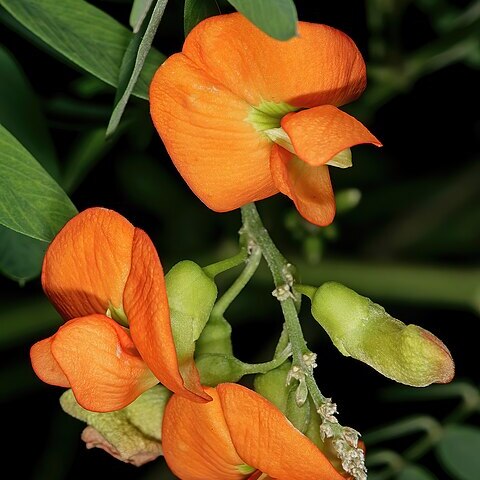Shrub or small tree, up to 3 m tall; branchlets sparingly appressed pubescent, becoming glabrous with age, obscurely 4-5-angled. Leaves imparipinnate, 5-8 cm long; stipules linear-aristate, 4 mm long; petiole 1-2 cm long, glabrous to sparsely appressed pubescent; leaflets opposite, in 3-4 pairs, oblong to oblong-oblanceolate, 20-30 x 6-8 mm, upper surface glabrous, lower surface glabrous to sparingly appressed pubescent, apex rounded; petiolule up to 2 mm long. Inflorescence terminal, racemose, 4-5 cm long, compact; pedicels 5-10 mm long, appressed pubescent; bracts minute. Calyx broadly campanulate, sparingly appressed pubescent, 4 mm long, 5 mm broad, 5-toothed; teeth short, the upper two subconnate. Corolla densely appressed pubescent without, glabrous within; vexillum suborbicular, 12 mm broad, clawed, calloused near the base; wings oblong-obovate, slightly falcate, 10 mm long, clawed, apex rounded; keel boat-shaped, clawed, 8 mm long, apex acute. Stamens 10, monadelphous. Ovary linear, 5 mm long, multiovulate; style incurved, 3 mm long; stigma capitate. Pod linear, compressed, 6-8 cm long, sparingly pubescent, dehiscent, thickened along the sutures; seeds 4-6, brownish, oblong-reniform, 7 x 3, 5 x 2 mm, with a median white hilum.
More
Shrub or small tree, up to 5 m high; branchlets sparsely appressed-pubescent. Leaves imparipinnate, 25-90 mm long, 5-13-foliolate, petiolate. Leaflets opposite, 10-30 x 5-8 mm, narrowly elliptic to oblanceolate, apex rounded to emarginate, upper surface glabrous, lower surface appressed-pubescent. Stipules subulate. Inflorescences terminal, pseudoracemes, compact with clusters of buds; peduncles 40-50 mm long. Flowers large, orange. Calyx widely campanulate, lobes unequal, broadly deltate with tapering apex. Petals: standard suborbicular, clawed, calloused near base. Style glabrous. Flowering time Oct.-Dec. Pod linear, compressed, 60-80 mm long, sparingly pubescent, dehiscent, thickened along sutures. Seeds 4-6, brownish, oblong-reniform.


